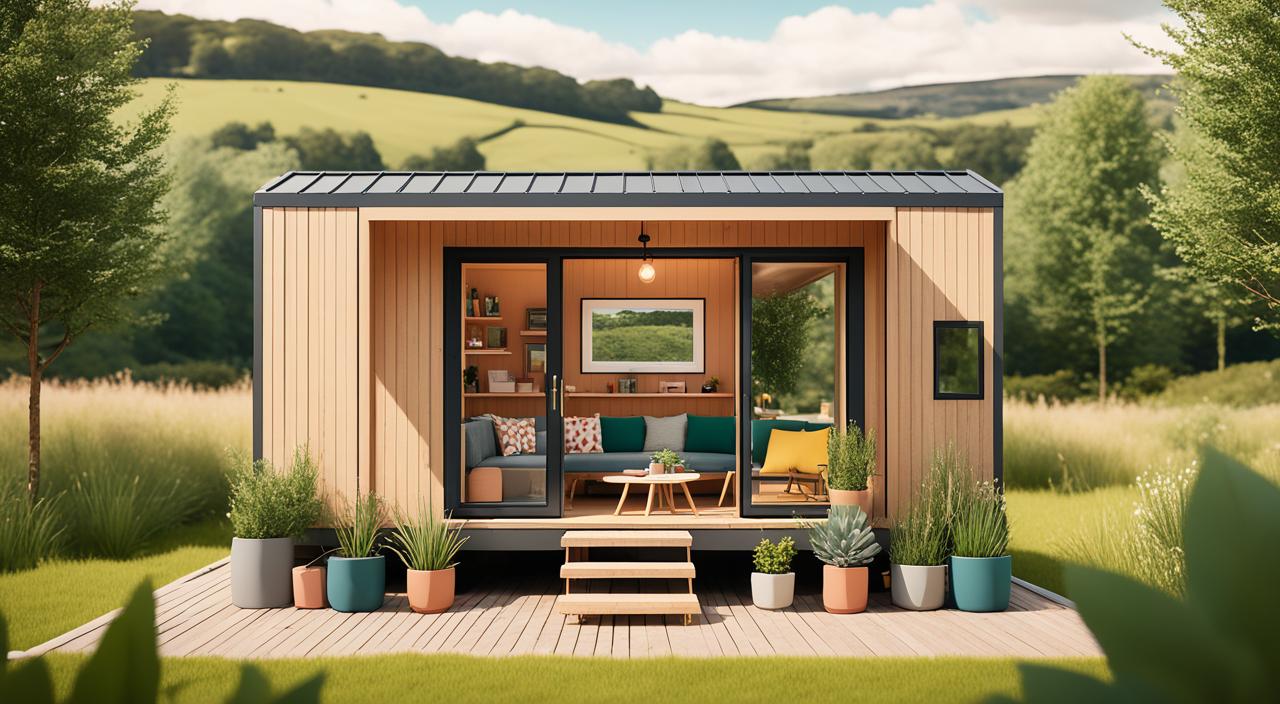In recent years, the buzz around tiny homes Boxabl has grown exponentially, capturing the imagination of those seeking not just a house, but a sustainable and innovative lifestyle shift. Pioneered by Paolo Tiramani, Boxabl’s entrance into the housing market in 2017 has signalled a potential upheaval for residential norms, especially for Britons grappling with housing affordability issues. But here’s the conundrum – can this overseas innovation truly intersect with the everyday housing needs of the UK?
The concept of affordable prefab tiny homes in the UK has been inching from the peripheries to the mainstream, but when it comes to Boxabl’s foldable abodes—heralded by the very likes of tech magnate Elon Musk—its transition from an American dream to a British reality presents a fascinating challenge. Evidently, the UK perspective on Tiny Houses is pivoting towards acceptance, but could Boxabl’s approach to compact housing genuinely become a cornerstone of this burgeoning movement?
Key Takeaways
- Insight into the revolutionary design and cost-effectiveness of tiny homes Boxabl.
- Understanding the UK’s interest in and adaptation to Tiny Houses from a UK perspective.
- Exploration of Boxabl’s scalability and its innovation in compact housing.
- Analysis of the current barriers hindering the availability of affordable prefab tiny homes in the UK.
- Anticipation of future prospects for Boxabl within the British housing market.
Understanding the Concept of Tiny Homes Boxabl
The innovation of tiny homes Boxabl is reshaping the housing industry, offering solutions to those who champion minimalism and sustainability. The concept of these compact living options has been garnering attention due to its unique approach to prefab tiny homes construction and the legacy of its founder, Paolo Tiramani. As urban areas become increasingly crowded, and the need for affordable housing rises, Boxabl presents an inventive and eco-conscious alternative.
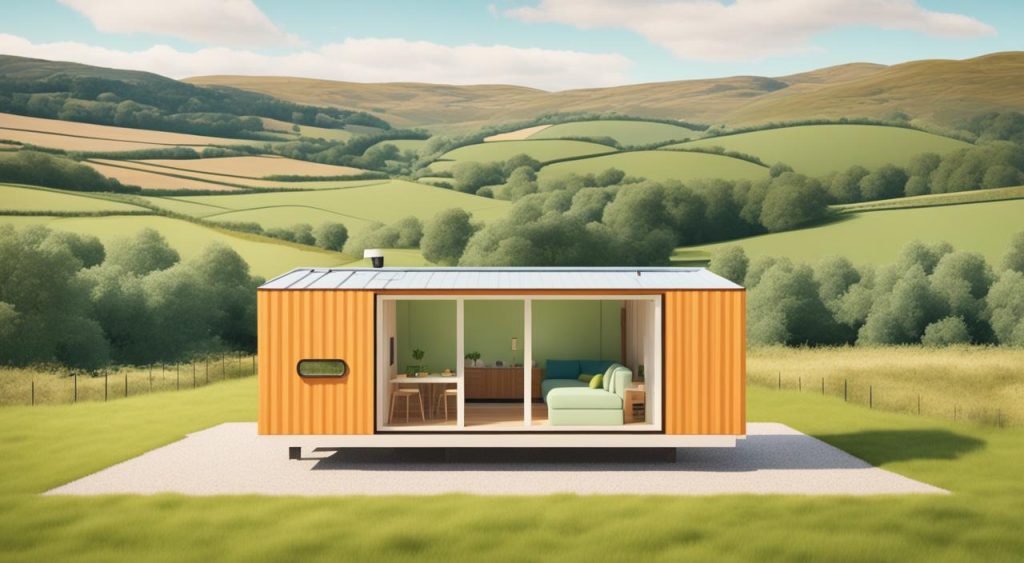
Origins and Founders of Boxabl
At the heart of Boxabl’s origins is the vision of entrepreneur Paolo Tiramani, who foresaw a revolutionary change in the construction of homes. Founded with the intent to address the burgeoning global housing crisis, Boxabl’s prefab tiny homes became the cornerstone of innovative, economical, and efficient living spaces. The company’s ethos lies in providing the ability to live large within a small footprint, reflecting Tiramani’s legacy in the realms of design, engineering, and invention.
Features of Boxabl Casita and its Uniqueness
- The Boxabl Casita is truly unique, boasting the capability to unfold from a compact box into a charming and functional abode in less than an hour.
- These prefab homes utilise a 19.5ft x 19.5ft floor plan, cleverly designed to incorporate all the full-sized amenities: a kitchen, bedroom, bathroom, and living area.
- Distinguished by its fire resistance and resilience against extreme weather conditions, the Boxabl Casita is not just a home, but a sanctuary.
- Boxabl’s modular nature facilitates personalization and adaptation, allowing homeowners to customise their spaces to their liking while also offering the feasibility of expansion for growing needs.
The compelling features of Boxabl Casita mirror the modern demand for flexible, compact living options without compromising on comfort or style. In the UK, where the concept of downsizing is gaining momentum, Boxabl represents a transformative movement towards practical, yet elegantly designed prefab tiny homes.
The Significance of Elon Musk’s Association with Boxabl
The fusion of Elon Musk’s vision for innovation and his recent decision to opt for living in a Boxabl unit has reverberated around the housing industry. This move resonates with Musk’s keen interest in sustainable living solutions and marks a noteworthy development in the public perception of modular, eco-friendly homes. Musk’s influence extends far beyond the spheres of space and electric automobiles; it now plays a pivotal role in reshaping the domain of innovative housing solutions.

Impact on Brand Perception
Elon Musk’s endorsement, though not through explicit investment, has had a formidable impact on Boxabl’s brand. As someone synonymous with transformational technologies and sustainability, his adoption of a Boxabl unit amplifies the product’s credibility and appeal. With consumers often taking cues from successful entrepreneurs, Musk’s choice of residence further moulds Boxabl as a practical and desirable housing solution in a market that is increasingly value-conscious and eco-aware.
Investment Implications
The association of such a high-profile figure with Boxabl has undoubtedly piqued interest among investors. Musk’s reputation for pioneering novel wheeling in technologically advanced sectors kindles speculation around Boxabl investment opportunities. This speculation suggests potential growth and profitability in the niche of eco-efficient prefab homes. Thus, Boxabl stands at the threshold of becoming more than just a brand; it may soon be synonymous with future-forward, accessible living, largely owing to the Musk effect.
Accessibility of Tiny Homes Boxabl in the UK Market
As the UK market for tiny homes burgeons, there’s rising curiosity around Tiny Homes Boxabl and their hallmark creation, Boxabl Casitas. However, amidst the fervour for such prefab solutions, the tangible accessibility of these homes to UK residents remains a topic of enquiry.
The Boxabl solution, designed for efficiency and convenience, hits a snag when it comes to availability outside of its native United States. Currently, UK residents face the challenge of a nascent market presence and a rather prohibitive barrier — the lofty shipping fees from across the pond. For instance, the cost of delivering a single Boxabl Casita from Las Vegas to London soars to an estimated £38,000, significantly inflating the otherwise affordable tag of these prefabricated homes. Accessibility of prefabricated homes in the UK then becomes not just a matter of demand, but also one of logistical viability.
- High international shipping charges impede the appeal of Tiny Homes Boxabl
- The UK market for tiny homes anticipates more cost-effective alternatives
- Limited production capacity creates a backlog, delaying potential UK availability
While the concept garners enthusiasm for its innovation and potential to revolutionise affordable housing, the availability of Boxabl Casitas in the UK is confined by current operational constraints. Enthusiasts of the tiny home movement are therefore on a watchful lookout for the evolution of Boxabl’s international reach along with possible local manufacturing options that might one day bring this hallmark of modern living to British doorsteps.
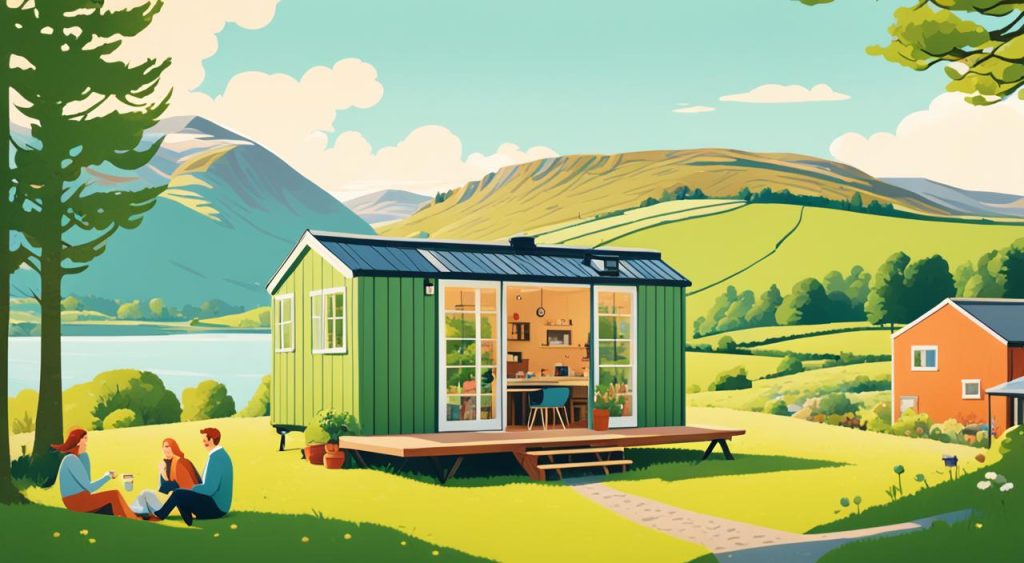
Dealing with the Demands: Overcoming Boxabl’s Long Waiting List
In response to the burgeoning interest in tiny home living, Boxabl has been at the forefront, yet it faces a nuanced challenge – a burgeoning waiting list that demonstrates the sheer magnitude of its demand. As prospective homeowners grapple with the anticipation of owning a Boxabl home, the company has committed to strategies aimed at scaling up production capacities to facilitate more rapid fulfilment of orders.
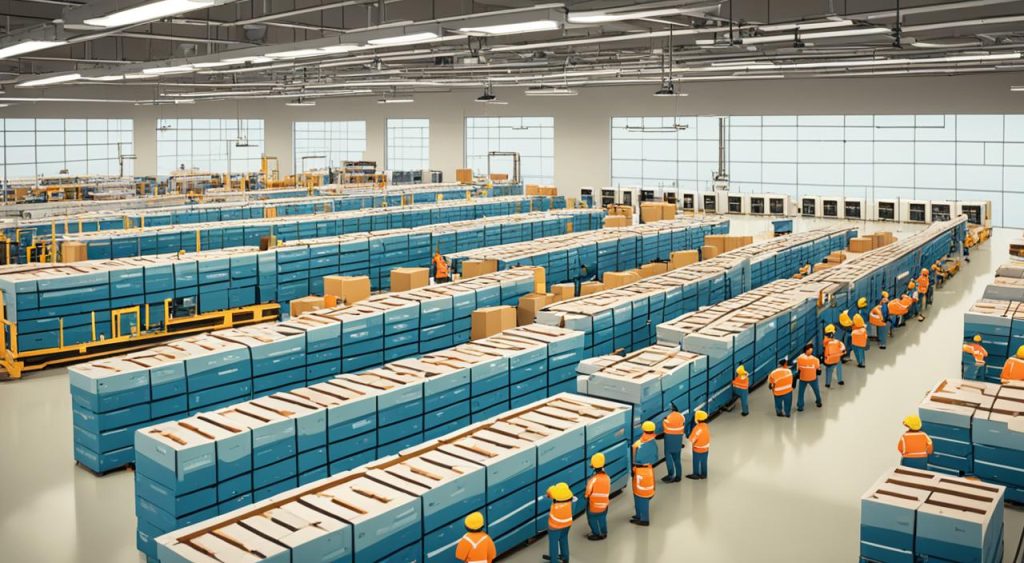
Scaling Up Production
The ambitious plan to enhance Boxabl’s manufacturing capabilities is a testament to the company’s dedication to dealing with its demand. Conscious of the necessity to reduce the extensive waiting list, Boxabl is charting a path towards establishing additional factories which will not only cater to escalating orders but also anchor the manufacturing processes closer to diverse markets, including potential future expansions in the UK.
Alternative Solutions for UK Residents
For those in the UK keen on the compact living lifestyle but deterred by Boxabl’s long waiting times, exploring alternative tiny home solutions represents a pragmatic course. The market boasts a spectrum of prefab homes that cater to various preferences, highlighting designs ranging from minimalist to luxuriously quaint, as well as incorporating eco-friendly features akin to those of Boxabl’s, such as solar panels and advanced insulation. These alternatives offer an immediate solution for UK residents, ensuring the dream of tiny home living is not deferred by waiting lists.
- Exploration of prefab homes of various designs and sizes on platforms like AliExpress
- Inclusion of eco-friendly features for a sustainable living experience
- Immediate access to tiny home solutions within the UK, bypassing waiting periods
Comparing Boxabl with Other Tiny Homes in the UK
When comparing Boxabl with UK tiny homes, it is apparent that the realm of alternative tiny houses within the British Isles offers a rich tapestry of options. In this assessment, we consider not only the aesthetic aspects but also the functional attributes that define the appeal of these residences.
The UK market demonstrates a propensity for diversity in its modular and prefab homes comparison, introducing a spectrum of designs, costs, and features that reflect the consumer’s personal taste and requirements. British customers are privy to alternative options that may include innovative eco-friendly systems, flexibility in design, and utilisation of different materials. This contrasts with Boxabl’s singular, albeit revolutionary, approach to prefabricated living spaces.
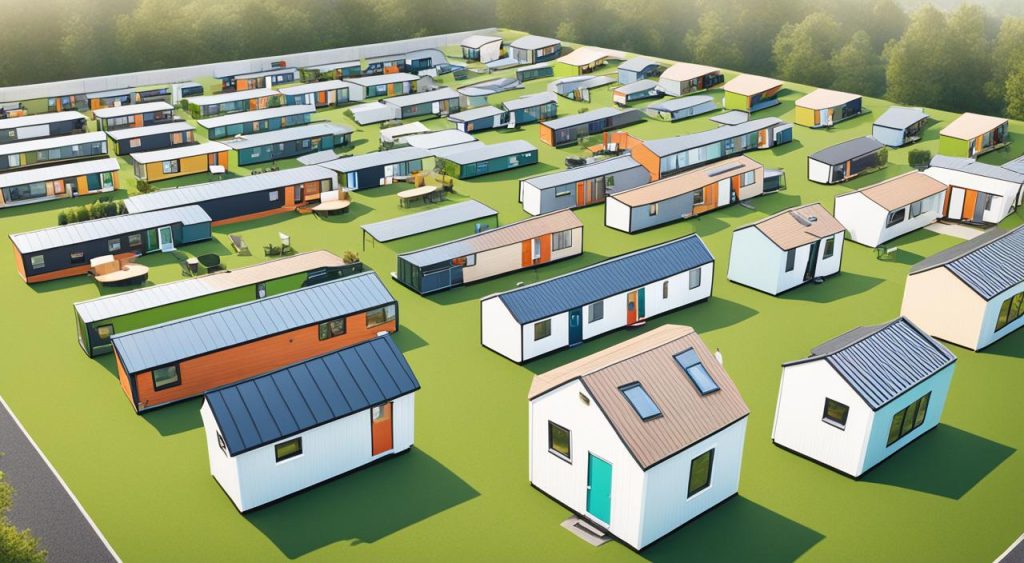
- Customisation Options: A multitude of UK companies offer the ability to tailor a tiny home to one’s particular preferences, something that is not as streamlined with the standardised Boxabl model.
- Affordability: The variety in the cost structure of UK-sourced tiny homes provides choices for budgets both modest and more substantial, while Boxabl maintains a single price point.
- Eco-Friendly Features: UK alternatives frequently boast renewable energy systems as integral components, whereas Boxabl homes offer this as an add-on.
Undoubtedly, the influx of Boxabl versus UK tiny home options sparks interest amongst potential homebuyers. Nevertheless, British consumers continue to show an affinity for the immersive level of customisation and detail provided by local manufacturers.
- The Qube and its sophisticated approach blending luxury with sustainability.
- Eco Pods, which emphasise minimal environmental impact and energy efficiency.
- Green Retreats, offering contemporary designs that harmonise with natural surroundings.
As we observe the elaboration of tiny home dwelling in Britain, the comparison between Boxabl and local alternatives underscores a market that is as unique as it is versatile, catering for an array of desires and functional demands.
Construction and Design Elements of Boxabl Tiny Homes
The construction of Boxabl homes is a testament to how design innovation can lead to significant strides in the housing sector. At the heart of these homes lies the ingenious use of structurally laminated panels. These aren’t your typical building blocks; they’re a composite of robust materials including steel, concrete, and EPS foam, which ensure a lifespan that surpasses that of standard construction.
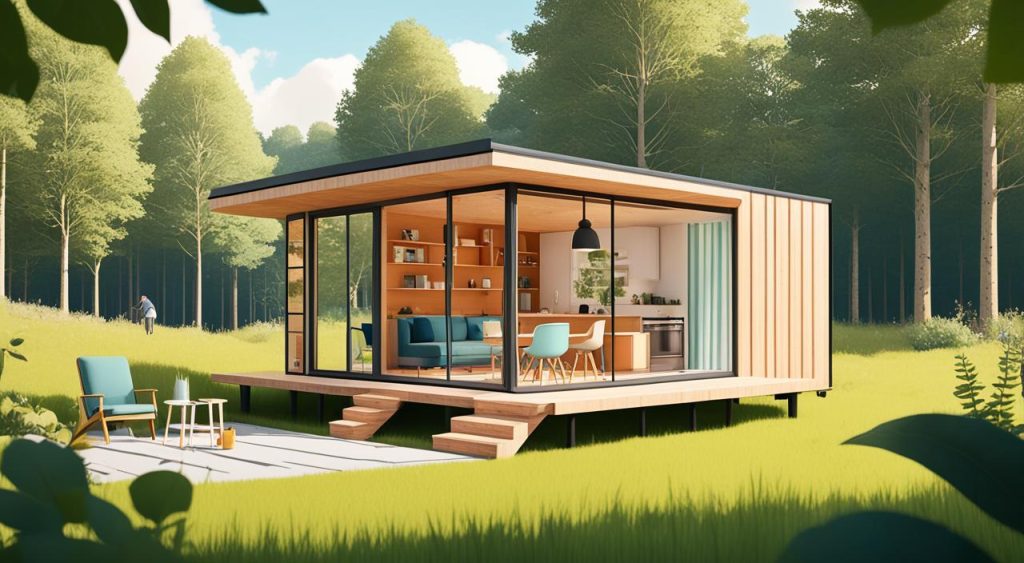
Such durable panels not only offer unrivalled strength but also contribute to the thermal efficiency of these cutting-edge homes. Through this composite structure, Boxabl delivers on its promise of providing high-grade, sustainable living spaces that are both practical and aesthetically pleasing.
Use of Structurally Laminated Panels
Boxabl is redefining the modular home with its use of structurally laminated panels. These panels, which amalgamate the toughness of steel, the solidity of concrete, and the insulating properties of EPS foam, have revolutionised the way we think about prefabricated construction. Together, they create a shell that is exceptionally resistant to natural elements, standing firm against the tests of time.
Foldable Technological Innovation in Housing
Another feat of engineering that Boxabl has pioneered is its foldable home design. This revolution in housing allows for a home to be transported compactly and then unfolded on-site, streamlining the building process remarkably. This novel foldable approach not only makes setting up a home a surprisingly swift operation but also represents a leap forward in constructing affordable and flexible living spaces. It’s a transformative concept that aligns perfectly with the increasing mobility of the modern homeowner.
These design breakthroughs underscore Boxabl’s role in leading the change towards more innovative, cost-effective, and environmentally conscious housing solutions. With such significant advancements, Boxabl homes are at the forefront of the foldable homes revolution, offering a glimpse into the future of construction and design.
Tiny Homes Boxabl: Redefining Affordable Housing Across the Globe
In an era where the necessity for affordable housing is more pressing than ever, Tiny Homes Boxabl emerges as a beacon of innovation, offering cost-effective and sustainable dwelling solutions that are within the reach of a broader demographic. With their Casitas priced at £50,000, Boxabl is not only revolutionising the concept of tiny homes but is also challenging traditional housing paradigms on a global scale.
Financial Aspects and Affordability
The allure of Boxabl homes extends beyond their practical design and modularity. Financial considerations play a pivotal role in their growing popularity. By providing traditional financing options, such as mortgages, Boxabl makes the dream of homeownership achievable for many, tackling financial aspects of tiny homes with unprecedented savvy.
Global Expansion Plans and Potential
While Boxabl’s roots are firmly planted in North American soil, the company’s vision for Boxabl’s global expansion foresees a worldwide footprint. Aspiring to bring affordable and sustainable housing to international communities, Boxabl continues to explore opportunities for manufacturing in new territories, laying the groundwork for what could be a global revolution in the housing sector.
Environmental Considerations of Tiny Homes Boxabl
Tiny Homes Boxabl stand at the forefront of the environmental sustainability movement in prefab housing, addressing critical concerns such as the environmental impact of tiny homes and their carbon footprint. Tailored for those who prioritise energy efficiency and ecological responsibility, Boxabl constructions are designed with the future of our planet in mind.
Energy Efficiency and Sustainability
The construction of a Boxabl house integrates materials renowned for their energy efficiency, like EPS foam, ensuring a high thermal insulation value or R-value. This not only enhances the comfort of occupants by maintaining a consistent internal temperature but also contributes significantly to the sustainability in Boxabl construction, by reducing the need for excessive heating and cooling. In doing so, it lessens reliance on energy grid demands and curtails utility costs.
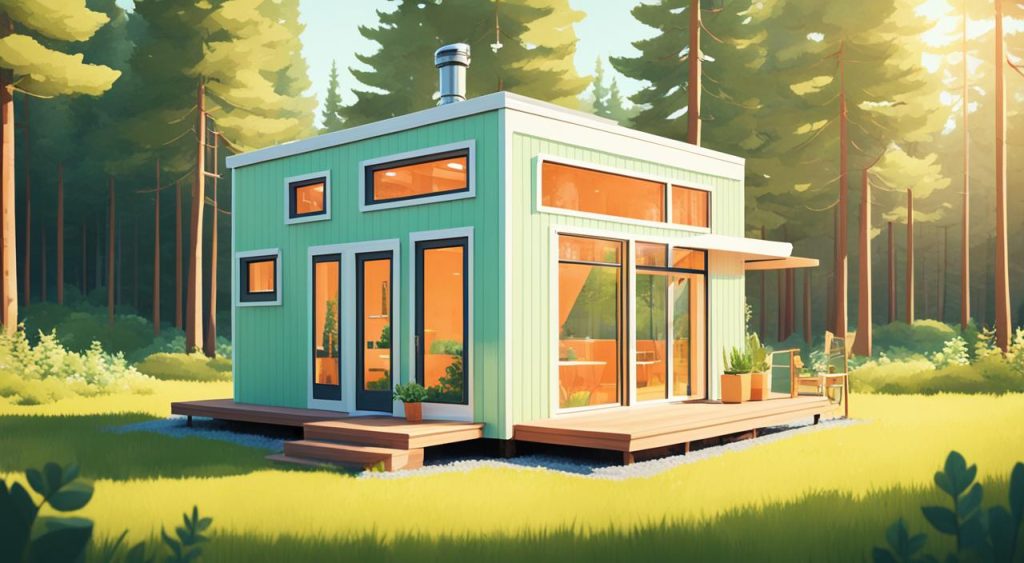
The sustainability angle is further reinforced through the minimal waste produced during construction, as the precise, prefab nature of the Boxabl assembly process diminishes unnecessary material usage. Such practices reflect a commitment to eco-friendly construction and a robust responsiveness to growing environmental concerns.
Options for Renewable Energy Integration in Boxabl Models
- Solar Power Adaptability: The modular design of Boxabl homes proves ideal for the integration of solar panels, facilitating the harnessing of renewable energy in prefab homes, thereby decreasing dependence on traditional power sources.
- Wind Energy Potential: The sturdy structure of Boxabl allows residents to explore the installation of small-scale wind turbines, where location and conditions permit, further enhancing energy autonomy.
- Rainwater Harvesting: Sustainable Boxabl models can be equipped with rainwater harvesting systems, providing a sustainable water source for non-potable use.
Through the incorporation of renewable energy systems and advanced design, Boxabl homes exemplify an eco-conscious living solution for those looking to significantly reduce their environmental impact while enjoying all the comforts of modern housing. Fostering an eco-friendly lifestyle has never been more attainable, nor more crucial, in the era of environmental awareness.
Legal and Logistic Aspects of Importing Boxabl Homes to the UK
The prospect of importing a Boxabl home into the UK is undoubtedly appealing for those seeking innovative and affordable housing solutions. Yet, the process is not without its complexities, requiring meticulous attention to detail when navigating logistics and legalities, international shipping, and regulatory compliance with UK building regulations.
Navigating Shipping Costs and Customs Procedures
Embarking on the international shipping of Boxabl units invites an intricate dance with cost assessments and customs clearances. The initial allure of cost-effective housing is met with the reality of considerable shipping expenses, encompassing transport fees, insurance, and potential import tariffs. Emphasising the need for due diligence, prospective importers must prepare for:
- An in-depth evaluation of freight charges, balancing transport types and routes to ensure optimal pricing.
- An accurate calculation of customs duties and Value Added Tax (VAT) payable upon the units’ arrival in the UK.
- The engagement with customs agents to ensure a smooth importation process, adhering to the UK’s customs regulations.
Addressing Modular Approval and Building Regulations
Once a Boxabl home reaches the UK shores, the odyssey continues with the labyrinth of legalities surrounding modular approval. Importing Boxabl to the UK is contingent upon the units meeting stringent local building codes and regulations. This requires:
- Thorough research and understanding of the UK’s specific building regulations to ensure compliance with structural, insulation, and fire safety standards.
- Consultation with local authorities and possibly hiring a UK-based architect or surveyor to facilitate the approval process of the imported modular home.
- The possibility of modifying the original Boxabl structure to align with the UK standards, potentially affecting the initial cost and setup convenience.
Undeniably, while Boxabl’s designs provide a tantalising glimpse into the future of housing, introspective reflection is advised for anyone in the UK considering this route. An informed approach to address the multifaceted legal and logistical landscape will be paramount in the successful integration of Boxabl homes into the UK living spaces.
Conclusion
In summarising the UK pursuit of creative housing options, Boxabl’s emergence has brought to the forefront an innovative solution addressing the critical challenge of affordability and sustainability in living spaces. While this American innovation, with its compelling cost-effective and eco-conscious prefab designs, has gained international intrigue, its penetration into the British market is still in infancy stages. Nonetheless, the dialogue around Boxabl has ignited interest towards pioneering solutions in the compact housing market.
Summarising the UK Perspective on Boxabl’s Innovation
The increasing curiosity in tiny homes Boxabl across the pond reflects a broader commitment to embracing novel architectural trends and construction technologies. The UK envisions driving down housing costs while maximising living standards, and with Boxabl’s strategy centred on streamlined design and durability, it has sparked consideration amongst British homebuyers and industry stakeholders. The synergy of such innovations with the UK’s commitment to environmental stewardship and space efficiency suggests a decidedly optimistic reception of Boxabl’s ethos.
Future Prospects for Tiny Homes Boxabl in the UK
Looking forward, the prospects for Boxabl’s tiny homes within the UK appear promising, shining a light on the broader potential for change in British housing. The pathway to locally produced, customisable Boxabl units could be transformative, offering a practical blueprint for residential construction that aligns with the UK’s rigorous building standards. Anticipation for the future is high as consumers and entrepreneurs alike await the day when these innovative solutions in compact UK housing transition from an overseas novelty to a domestic reality, potentially reshaping the very landscape of UK housing with their introduction.


